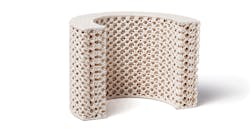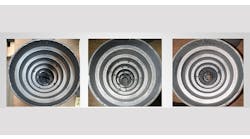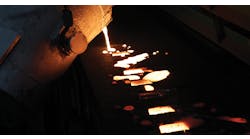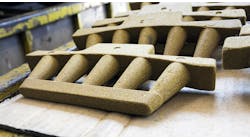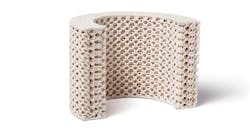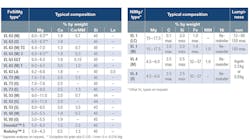Q: We’re pouring ductile and compacted graphite irons (CGI) and we’re looking for magnesium ferrosilicon (MgFeSi) alloys that will suit our practices for both types of products., Do you have any advice to help us pour these irons more reliably? How can we evaluate the benefits of the different MgFeSi alloys and their constituent elements?
A: Magnesium ferro-silicon alloys are an essential part for the ductile and CGI manufacturing process. It is important to remember that the percentage of magnesium in the final casting should be within a specific range (depending on the ductile or CGI alloy.) Normally, if you are pouring ductile iron a range of 0.035-0.045%, magnesium is expected to optimize the number of nodules in the finished casting. If this range is higher than specified, then defects such as exploded graphite nodules, dross defects (MgO), intercellular carbides, and shrinkage porosity start to appear. For magnesium ranges lower than what is specified for ductile, we will not have enough Mg content to form the graphite nodules needed for the casting.
For CGI alloys, a range of 0.015-0.023% Mg in the final casting will yield the highest CGI microstructure for the casting. If the final casting had magnesium ranges lower than that specified for ductile and CGI, then the finished product will have a microstructure (flake graphite) usually found in a gray iron alloy. Achieving these ranges is important, in order to know the magnesium recovery of the practice employed.
As is known, a pour-over or sandwich treatment process (30-50% recovery, generally) will be less efficient than a tundish treatment process (50-70%.) It is also important to understand that a certain treatment temperature also is essential for ductile and CGI manufacturing. At higher temperatures, the rate of loss for magnesium is higher, which is why the best range for treatment is normally around 2,650-2,700°F (1,454-1,482°C.)
The most popular treatment alloy is a 5-6% MgFeSi alloy, because of the high recovery rates it achieves. This alloy is accompanied by other elements to optimize the microstructure for ductile or CGI alloys. Calcium is one element included with the product. The magnesium reaction with molten metal is very volatile, and therefore at an adequate percentage the calcium helps to calm the reaction. It also helps to delay the onset reaction and reduces the subsequent fade rate of the magnesium.
Rare earth (RE) alloys (e.g., cerium and lanthanum) are another element that is added to the MgFeSi alloysm primarily to counteract the deleterious effects of subversive elements commonly present in cast irons (such as S, O2, Bi, Pb, Sb and Ti.) A proper balance of REs results in superior microstructure, mechanical properties, and less risk for carbides and shrink defects. In excess, REs can result in carbide defects for thin casting sections, while in heavy sections RE not balanced with Bi and Sb will result in chunky graphite.
Tecproloy MV is the name of an ASK product that satisfies these standards. Tecproloy MV achieves high quality controls and is manufactured for pour-over, sandwich, tundish, pocket, in-mold, and porous-plug methods.
Though foundries typically prefer this alloy, this does not mean it is the only option. We have a range of products that can be chosen from depending on the preference. We have MgFeSi alloys that have higher Mg percentage (up to 11% magnesium) and alloys that have as low as 3.8% Mg. The various products also have a specific addition of Ca, RE, and Si in their composition to optimize the reaction.
Lastly, we offer have nickel-magnesium (NiMg) alloys that facilitate small additions of magnesium to the iron. Because of the high density of these products, they sink to the bottom and hence magnesium recoveries are high and consistent.
Join the Conversation. Email Your Questions for ASK Chemicals
Share your insights, opinions, and elaborate on the questions and the experts' answer(s.) You must be logged in to the website in order to post your comments.
